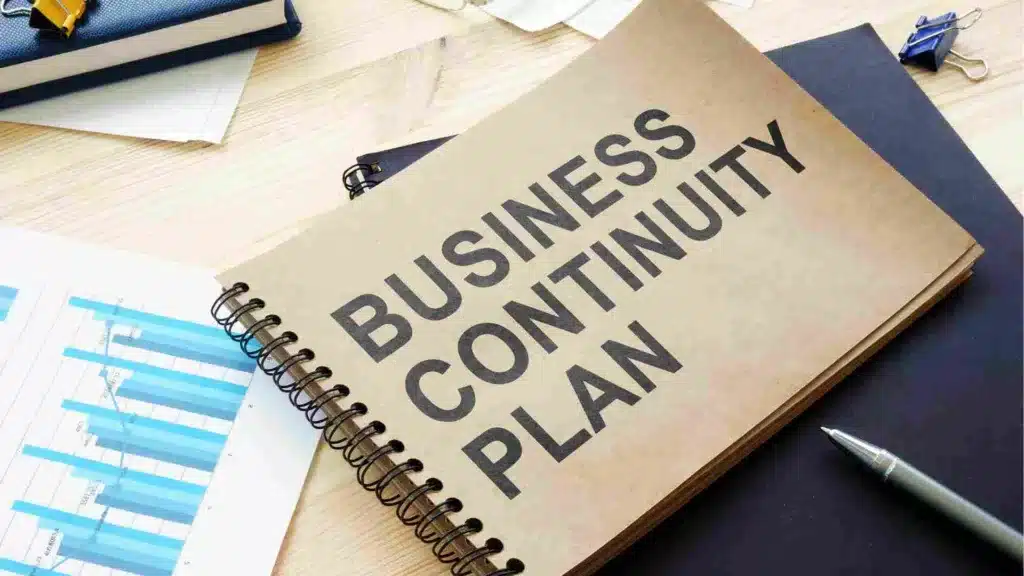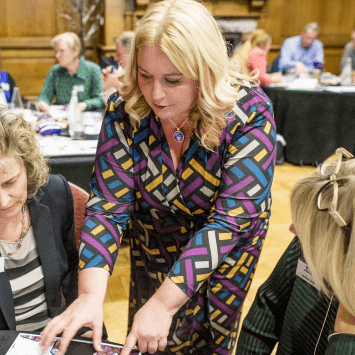Posted in Blog, Entrepreneurship, Facilitation by Jo North
Business Continuity Workshop for Your Business or Team: Facilitation Ideas
In this article, I give you a step-by-step guide on how to facilitate a business continuity workshop for your business or team. I’ve designed this business continuity workshop agenda to help you either kickstart or refresh your business continuity plan.
I’ve tried and tested all these activities many, many times. You can have confidence that this is a great workshop format that will deliver the information you need.
The agenda leads to a clear strengths and gaps analysis of your business’ resilience in the face of a significant disruption.
What is Business Continuity?
Imagine waking up one morning to learn that a natural disaster has hit your location. Local businesses, including your favorite coffee shop or the small business next door, as well as large companies, are affected. This is where the concept of business continuity comes into play.
Responding to Business Disruption
Business continuity is all about having a solid plan to ensure that essential functions and business processes can continue or be quickly restored after a disruptive event, be it a ransomware attack, a supply chain breakdown, or any other business disruption.
Business Continuity Planning
At the heart of this is business continuity planning. Business leaders and their teams work together to understand potential risks. They conduct a business impact analysis to determine the potential impacts of disruptions on their business unit or the entire company. This is followed by a risk assessment to spot potential risks that could disrupt normal operations.
Now, how do businesses prepare? They develop business continuity strategies. These might include creating a disaster recovery plan to recover data or setting up crisis communications methods, like having a dedicated email address for emergencies.
Business Continuity Management System
A successful business continuity management system doesn’t just end at plan development. It involves regular training programs, including in-house training for staff, to ensure everyone knows the basics of business continuity. This might also mean running a business continuity plan exercise to test and refine the plan.
For small businesses, understanding the best practices in business continuity can be crucial. They might not have the resources of larger corporations but can still create their own plans tailored to their needs.
Crisis Management
Crisis management is about handling the situation as it unfolds, while risk management is about identifying and mitigating threats before they happen. And if an event does occur, an incident response team kicks into action to manage the situation.
Collaboration
In addition to using internal resources, businesses may collaborate with external agencies for a comprehensive solution. The goal is to minimize the downtime and get back to business in as few business days as possible.
Furthermore, business continuity planning is not a one-time event. It’s an ongoing program management task that evolves with new challenges. To help businesses stay prepared, you’ll need to run training programs, evaluation programs, and provide resources to ensure that continuity plans are up-to-date and effective.
Business Continuity Planning is Essential
Whether you’re a business leader of a large corporation or you run a local shop, having a plan to tackle disruptions is essential. It ensures that when faced with challenges, businesses can continue to operate and serve their customers. Business continuity is all about preparation, adaptation, and quick response, ensuring that disruptions, no matter how big or small, have minimal impact on operations.
Facilitation Agenda for Your Business Continuity Workshop
This business continuity workshop agenda will:
- Increase understanding and awareness of what business continuity is, and its importance, amongst your team
- Achieve a strengths and gaps analysis of your company’s readiness for the principle categories of business disruption. The next step after the workshop will be to work to fill the gaps, and create a set of business continuity plans that are ready to use.
What to Expect from the Business Continuity Workshop
During the workshop, the team will work together to answer these questions:
- What are the business’ critical operations?
- What are the risks to these activities?
- What incidents might impact them?
- How will we maintain these critical activities in the event of an incident?
- How might these impact wider business operations?
- What next steps do we need to take to strengthen our response?
Step 1: Business Continuity Workshop – Identify Critical Business Operations
Critical business operations are the key activities a company must do to keep running and serve its customers. If these operations stop, the business could face serious problems.
Ask the group to work in small teams to identify your company’s critical business operations.
Show the Step 1 template below, and ask your participants to work together to complete it, as follows:
- List all the critical activities that the business provides, with a short description
- Describe the impact on customers of each activity, should any significant disruption occur, with a High, Medium or Low impact rating
- Explain the impact on the business for each activity if a significant disruption were to prevent it from taking place. Give it a High, Medium or Low impact rating.
Do not get into the detail of different types or causes of significant disruptions. The type of disruption does not matter at this stage. You’re simply focussing on the impact of not being able to perform the activity.
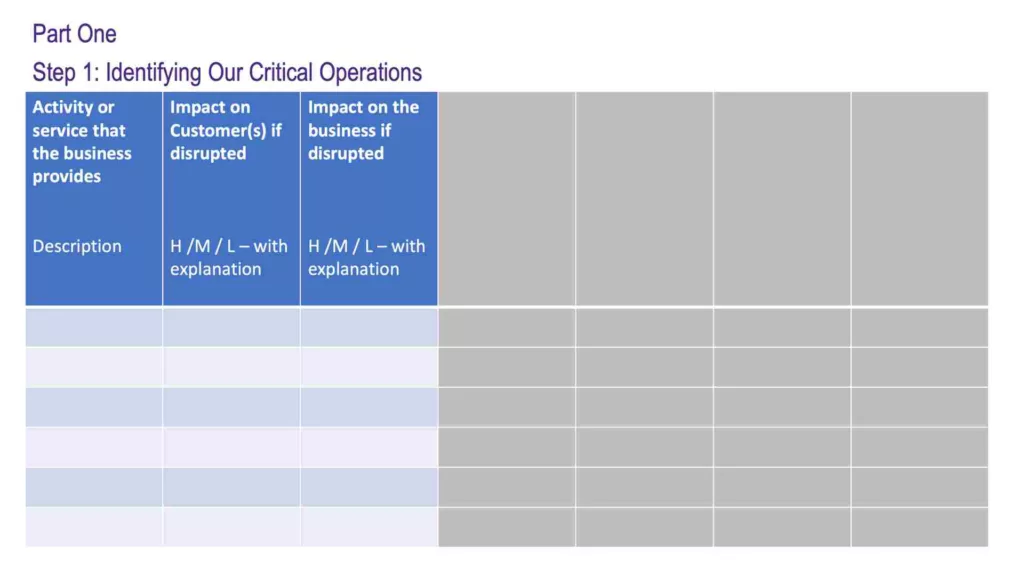
Step 2: Business Continuity Workshop – Identify Critical Business Operations
Show the right hand side of the template below.
Ask the group to consider and write down what the impact would be in the case of of a significant business disruption for each activity for:
- The first 24 hours
- 24-48 hours
- Up to one week
- Up to two weeks
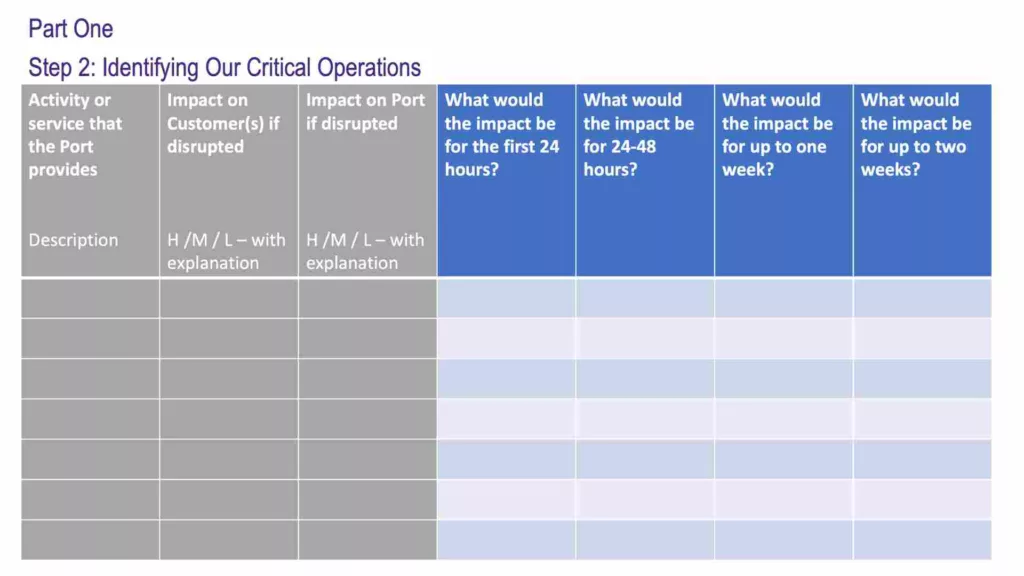
Step 3: Maximum Tolerable Period of Disruption
Ask your delegates to discuss and write down the maximum tolerable period of disruption for each activity.
Definition of Maximum Tolerable Period of Disruption
The maximum tolerable period of disruption is the longest time a business can be interrupted before it causes severe harm. After this period, the business might not recover.
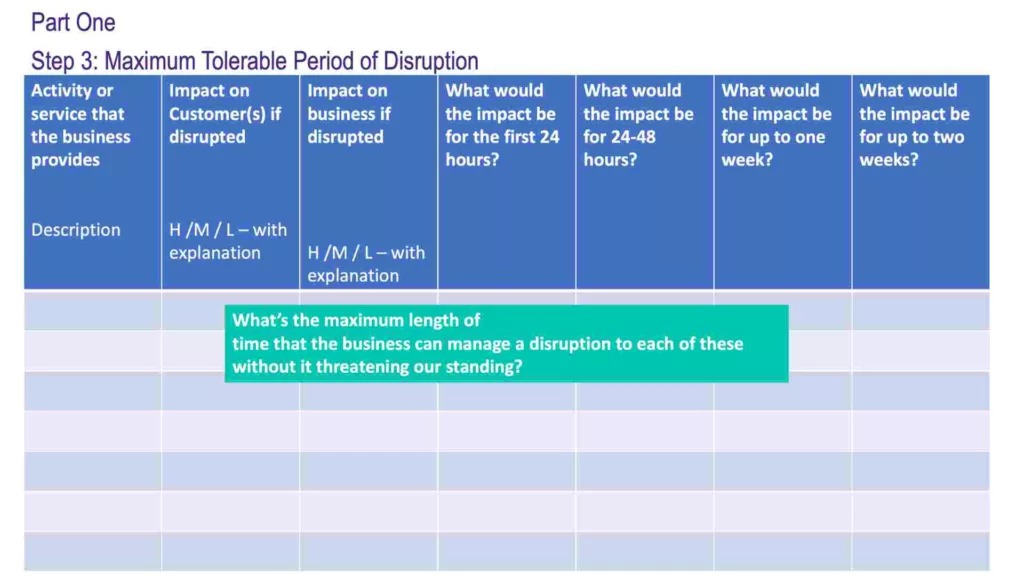
Step 4: Review and Prioritize
Ask your groups to transfer the names of each of the activities from the first column in the template you’ve been using in Steps 1-3 above onto sticky notes. They should write the name of just one activity per sticky note.
Next, your participants should review the activities on the sticky notes, and use the grid below to prioritize them as follows:
Prioritize the activities by size of impact and maximum tolerable period of disruption:
- The highest impact and shortest maximum tolerable period of disruption is the highest priority.
- The lowest impact and longest maximum tolerable period of disruption is the lowest priority.
Each sticky note needs to be placed in the relevant section of the grid.
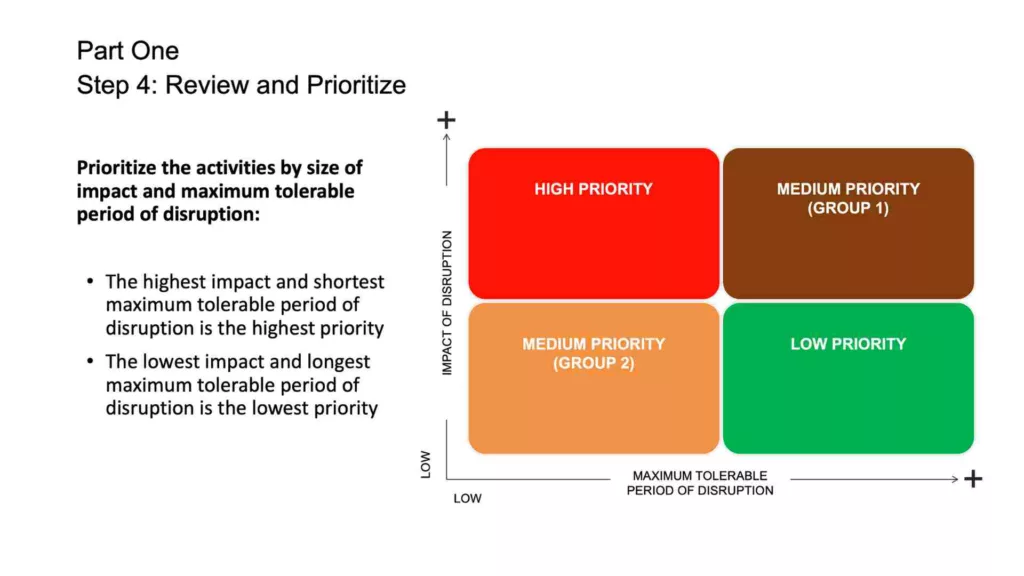
Step 5: Risk Assessment
Types of Business Disruption
Business disruptions usually fall into one of these types:
- Loss of IT and communications
- Not enough staff
- Loss of utilities, i.e. water, gas, power
- Transport distribution issues
- Cannot access premises
- Loss of key suppliers
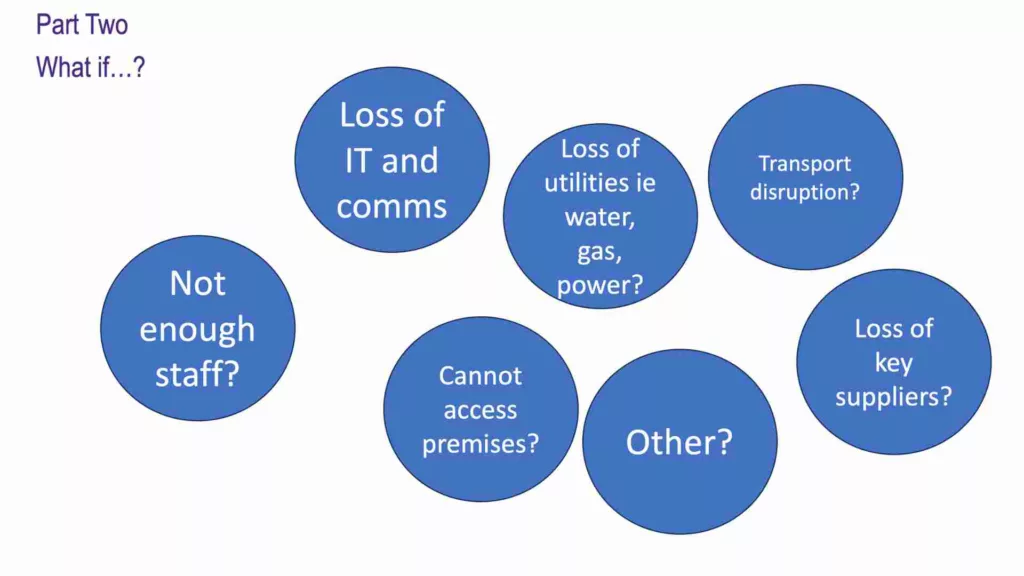
Risk Assessment
The next step in your business continuity workshop is to carry out a risk assessment for each of the activities the group identified as high priority in Step 4 above.
In business continuity planning, a risk assessment identifies potential threats to a company and evaluates how much damage they could cause. This helps businesses prepare and protect themselves.
Use the template below.
Ask your delegates to describe the impact of each type of business disruption on each high priority activity. They should also give a High, Medium or Low impact rating.
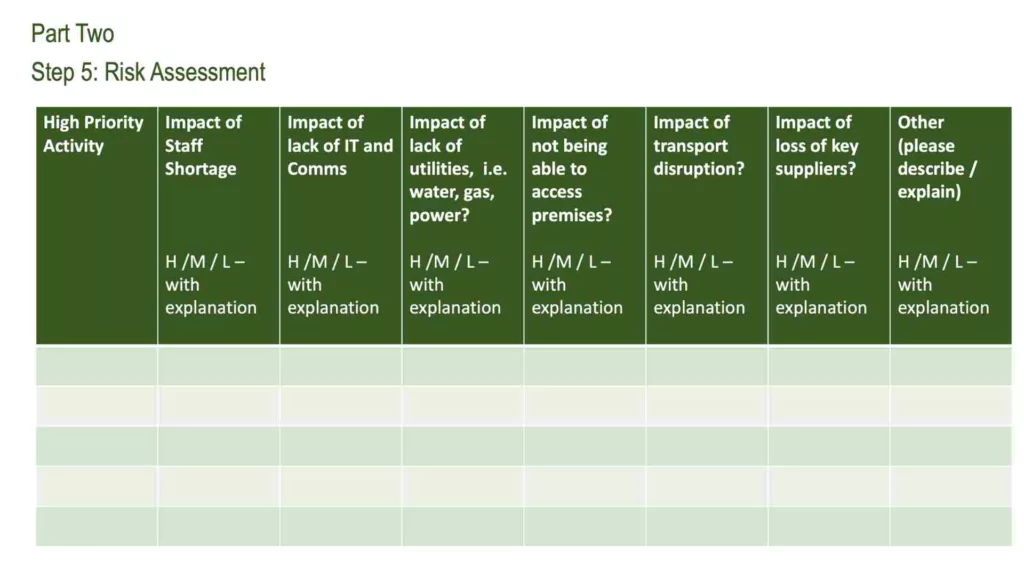
Step 6: Risk Mitigation
In business continuity planning, risk mitigation is the action a company takes to reduce or prevent the damage potential threats could cause. It’s about being proactive, resilient and safe.
This final step in your business continuity workshop creates a strengths and gaps analysis of how well placed your company is to deal with significant disruptions. It helps you to identify what you need to work on to further strengthen your business resilience.
Starting with the High Impact items, ask your delegates to list what plans, procedures, processes or SOPs (Standard Operating Procedures) you have to help deal with these situations, should they occur. These items need to be written down or recorded visually, not just common practice, or in people’s heads.
If your delegates don’t know, ask them to mark it with “?”
In the case that your participants know that nothing exists, ask them to show it with an “X”.
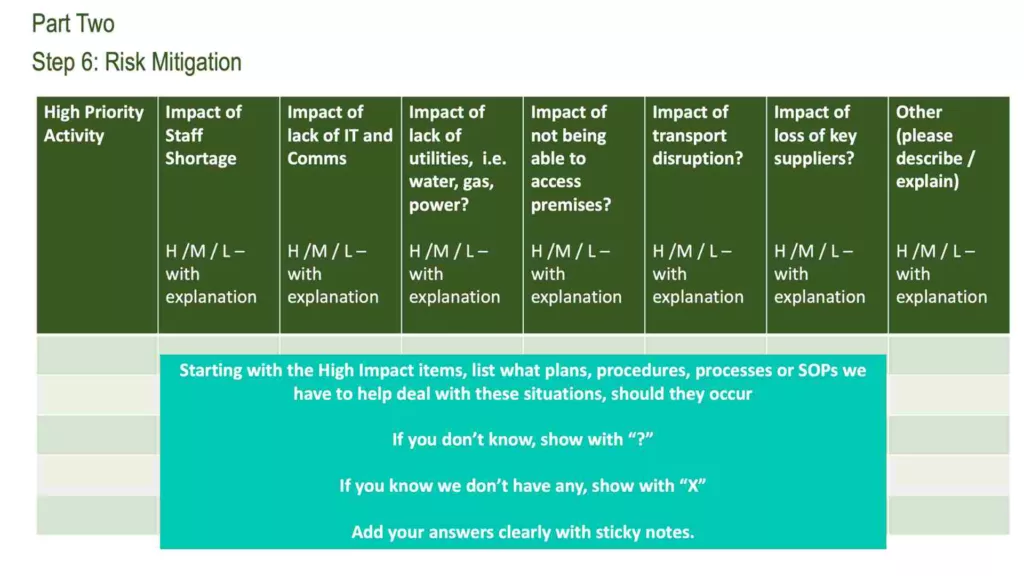
Once your delegates have completed this, you can facilitate an action planning discussion to identify the steps the business needs take to create or improve business continuity plans for each of your business critical activities.
Next Steps
I hope that you’ve found my article and the agenda that I’ve created for you useful.
If you have any questions, or suggestions, please do get in touch with me here. I’ll be delighted to help.
My team and I will also be delighted to design and facilitate your business continuity workshop for you, either online or face-to-face. Please contact me here of you’d like to explore this further.
